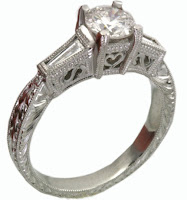 |
| 245 Main St. El Segundo, CA 90245 310-322-8060 bluediamondjeweler.com |
Are you in the market for a diamond? Whether it's an engagement ring or a pair of stud earrings, there are plenty of factors that go into purchasing a diamond. The main one's to consider are called the 4 C's of a diamond and are actually very easy to understand. So let us here at Blue Diamond Jewelers explain to you as simply as possible.
The 4 C's of diamonds are:
Carat Weight
Cut
Color
Clarity
First is Carat Weight:
 |
| Weighing a diamond to figure out the carat weight. |
One of the biggest misconceptions is that carat weight refers to the size of a diamond. The bigger the carat weight, the bigger the diamond, right? Technically yes, but in all actuality it's how heavy the diamond is weighed in carats as opposed to grams or ounces.
The easiest way to explain carat weigh is pennies on the dollar. One carat is equal to 1.00 carats (give or take a few points) so by comparison a half carat diamond would weigh around .50 carats.
Keep this in mind when purchasing a diamond that carat weigh is actual weight, not size. The size is factored in the second C of the four C's.
Second off is Cut:
 |
| An rough diamond ready to be cut to perfect proportions. |
Cut is how a diamond changes from rough to all the different shapes of a polished diamond. When a rough diamond is cut, the diamond cutters try to balance the proportions of the diamond to optimize the size and distribution. In turn this makes sure that your diamond has the most fire, scintillation, and brilliance.
 |
| Light entering the three different cuts of diamonds. |
The main factor when cutting a diamond is making sure that the proportions are as close to ideal as possible. If a diamond is cut too shallow, then it will look big from the top but light will go in and then leak out the bottom. If a diamond is cut too deep then all of the weight of the diamond is at the bottom, and when the light enters through the top it then bounces and leaks out the sides. The best way to cut a diamond is to balance enough of the weight between the top and bottom, which in turn allows light to enter through the top bounce of the sides and then exit through the top giving you all the sparkle, flash, and shine that you want from a diamond.
Third is Color:
When a diamond is formed, carbon is compressed under a tremendous amount of pressure over a long period of time, deep in the earth. After time the carbon is turned into a beautiful clean clear diamond, however if traces of nitrogen are with the carbon during formation the diamond can have tints of yellow or brown. As such a grading scale was created to show the range of diamonds that are clear and those that have that yellow tint.
Diamonds that are clear without any heavily noticeable yellow tint are graded as D,E, or F are considered colorless. G,H,I, or J are in the near colorless range for diamonds and usually have just a slight yellow tint that isn't hugely noticeable. K-Z is where the yellow tint is easily noticed and becomes more intense the further down the alphabet the letter is.
Forth is Clarity:
As we discussed in color, a diamond is made from carbon being compressed over a long period of time. As such when it's compressed sometimes small marks can form on the inside of a diamond giving them specific birthmarks within the stone. Characterized as "inclusions", the marks on the inside don't make a diamond any less durable but do affect the price point. Diamonds with less inclusions are more rare and in turn more valuable, whereas diamonds with more inclusions are plentiful and usually less expensive.
Grading for clarity goes as follows:
- I1, I2, and I3 - The lower grades for clarity, these grades are given to diamonds with inclusions that are clearly visible to the naked eye.
- SI1-SI2 - This grade is given to diamonds that have very slight inclusions, some may be noticeable and some may need 10 times magnification to see.
- VS1-VS2 - Diamonds with the VS grade are considered as very slightly included. The inclusions are very difficult to see without 10 times magnification.
- VVS1-VVS2 - Very very slightly included diamonds, extremely difficult to notice any inclusions internally without intense magnification (usually over 30 times magnification).
- FL-IF - Flawless or Internally Flawless diamonds are the best of the best. These diamonds have nothing that can be noticed under intense magnification and are the most rare to find.
The four C's of a diamond may seem complicated, but with this basic knowledge in mind buying a diamond becomes a little less complicated. Of course, we at Blue Diamond Jewelers are more than happy to help explain them even further. So come on in and we'll be glad to help you find the perfect diamond for whatever your needs.
Blue Diamond Jewelers
245 Main St.
El Segundo, CA 90245
310-322-8060
BlueDiamondJeweler.com







